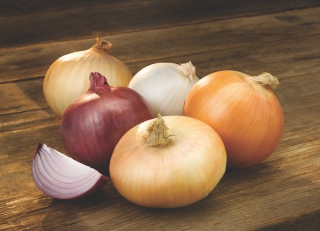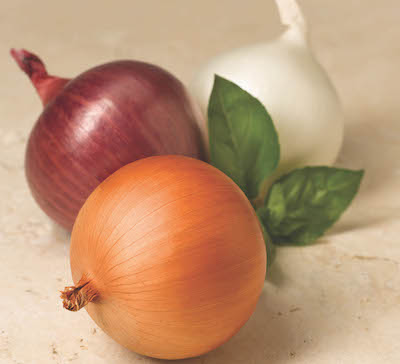
Onions - Layers of Flavor
01 November 2016Instructors can use new online onion curriculum to teach students about traits, flavors and best uses of onions.
By Kim Reddin, National Onion Association’s Director of Public and Industry Relations
Onions have long been a staple in the foodservice industry. From soups to sandwiches to appetizers to salads, onions add color, texture and flavor. The onion is a ubiquitous ingredient in kitchens throughout the world. No matter what the cuisine, chances are the recipe begins with the chopping of an onion.
Onion History, Production and Consumption
Onions may be one of the earliest cultivated crops because they were: less perishable than other food of the time; transportable; easy to grow; and could be grown in a variety of soils and climates. In addition, onions were useful for sustaining human life. Onions prevented thirst and could be dried and preserved for later consumption.
 While the exact place and time of origin is a mystery, onions found their way into diverse cuisines long before man began to record recipes.
While the exact place and time of origin is a mystery, onions found their way into diverse cuisines long before man began to record recipes.
World onion production is estimated at approximately 105 billion pounds each year. At least 175 countries grow onions. Leading onion production countries are China, India, United States, Turkey and Pakistan, respectively.
Onions are grown in 20 states from coast to coast. Leading U.S. onion production areas are California, Idaho-Eastern Oregon and Washington. Growers in the United States plant approximately 125,000 acres of onions each year, which yield about 6.2 billion pounds for fresh consumption.
The United States accounts for 1.6 percent of the world onion acreage and produces about four percent of the world’s annual supply. The U.S. dry bulb onion crop value exceeds $1 billion at farmgate and generates $5 to $7 billion at consumer purchase level.
The average annual world consumption of onions is more than 13 pounds per person. Libya has the highest reported use of onions with an astounding average per capita consumption of 66 pounds. U.S. per capita onion consumption has risen over 70 percent in the last two decades, from 12.2 pounds per person in 1982 to 20 pounds per person in 2010. This volume translates into more than 450 semi-truck loads of onions each day.
Onions Types, Color and Sizes
A domestic supply of onions is available year-round and they can be divided into two categories: spring/summer and fall/winter.
Spring/Summer Onion Traits
- Availability: March through August
- Skin: one or two thin layers, often transparent and lighter in color, especially yellow varieties
- Water Content: high, which leads to a shorter shelf-life (30 to 60 days) and easier bruising
- Flavor: sweet to mild
- Best Uses: raw, pickled, lightly-cooked or grilled
Fall/Winter Onion Traits
- Availability: August through May
- Skin: multiple, thick, paper-like layers, darker in color, especially yellow varieties
- Water Content: lower than Spring/Summer, which leads to longer shelf-life (30 to 180 days)
- Flavor: mild to pungent
- Best Uses: raw, caramelized, roasted, grilled, fried or any dish with a long cook time
In general, onions with a higher water content (Spring/Summer fresh onions) take slightly more time to cook. Onions with a higher percentage of solids (Fall/Winter storage onions) will cook in less time.
Bulb onions can be yellow, red or white.
Onions range in size from less than one inch in diameter to more than 4 1/2 inches in diameter. The most common sizes sold in the United States are medium (2 to 3 1/4 inches in diameter) and large/jumbo (3 to 3 3/4 inches in diameter).
New Curriculum
The National Onion Association recently released its Onions Layers of Flavor Culinary Curriculum, a new online culinary education guide for students, culinary instructors and professional chefs.
The Onions Layers of Flavor Culinary Curriculum includes lessons on onion history and production, storage and handling instructions as well as information on the types, sizes, and colors of onions. Preparation methods and proper cutting techniques are also included. The onion curriculum is accompanied by a slide show and is available athttps://www.onions-usa.org/foodservice/culinary-education.
Onions Layers of Flavor Culinary Curriculum is approved for 3.0 continuing education hours toward initial or recertification application ACF certification. Note: These programs are not endorsed, accredited, or affiliated with ACF or the ACF Certification Program. Participants who complete and return the online quiz and evaluation will receive a certificate from the National Onion Association.
For more information about onions, visit www.onions-usa.org
Photos courtesy of National Onion Association.